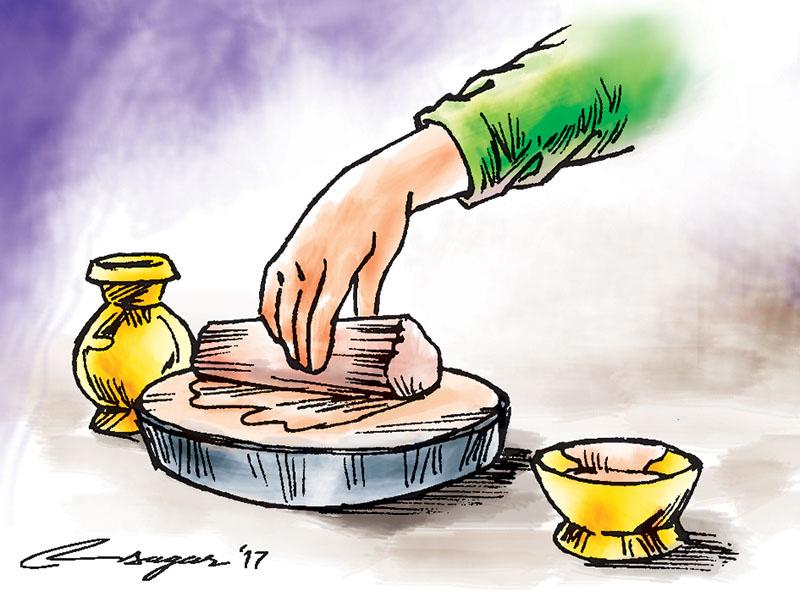Sandalwood seeds: Tapping the full potentials
Germination of sandal seeds is found to be profuse from the bird droppings on the forest floor as well as in the village yards and bunds of the agricultural fields. This indicates the potential of growing the tree in farmlands
Sandal (Santalumalbum L) is one of the most precious timber yielding plants due to its medicinal properties since ancient times. This became domesticated for its various uses. Though it has natural regeneration capability the rate is not sufficient and uncertain. There is a huge demand for its saplings in Nepal where pilgrims travel to visit holy places. There are lots of problems on seed germination in natural as well as other conditions. This can be accomplished by raising quality planting stock using known and superior seed source material and adopting modern nursery practices. Some trees grow in the forest gardens, and are almost extinct due to smuggling. The only way to counter smuggling and to meet the country’s demand for sandalwood is by encouraging sandal domestication which may be an option.
Easy technology should be explored. Considering all these consequences, the authorities of Nepal Science and Technology have undertaken the venture for its mass propagation by performing location trial experiments since over a couple of years for its survival and to explore the areas of suitable as well as congenial factors.
The widely distributed and economically important Santalum genus belongs to family Santalaceae, which includes 30 genera with about 400 species, many completely or partially parasitic. The word sandal has been derived from Chandana (Sanskrit), Chandan (Persian), Savtador (Greek) and Santal (French). There are references of sandalwood in Indian mythology, folklore and ancient scripts. ‘Chandana’, the Sanskrit name ascribed to Santalum album L., was known and used in India from the earliest historical times and is frequently mentioned in the ancient Sanskrit writings, some of which dated before the Christian era. Kautilya’s Arthashastra (320 B.C.) considered sandalwood as one of the important forest products to increase royal revenue. Charaka Sanhitha, the major textbook of internal medicine in Ayurveda (300 B.C.), quotes uses of sandal over 160 times in the entire text. In treatment of major diseases like fever, piles, hemorrhagic conditions, diabetes, dropsy, mental disorders, management of poisons and skin disorders, widespread uses of sandal are seen. Susrutha Samhita (150 B.C.), a great text on Indian wisdom on surgical procedures, equally preferred sandal for the management of wounds. Sandal fumigation is indicated in warding off evils and organisms which contaminate the wounds. Such fumigation hastens the wound healing and surgical wards remain aseptic. Dusting of wounds with sandal for early healing is common. In the Amarkosha (Lexicon 3rd or 4th Century A.D.) sandal is mentioned and it is said ‘Vina-malayam anyathra chandanam vivarditha’.
The extraction and disposal of sandal came under the Forest Department in 1864 in Mysore state. In Karnataka (formerly Mysore) the forest working plan for sandal extraction was prepared for Hunsur Talik in 1910, Heggadadevanakote in 1920 and Narasimharajapura in 1926. In 1871, the parasitic nature of sandal was reported by John Scott. Watt (1893) described the technique of raising sandal seedlings in tile pots in nurseries and in fields. McCarthy (1899) first noticed the spike disease of sandal in Coorg. Brandis (1903) suggested that though sandal is a root parasite, it may derive part of its nutrition from the soil as well. Barber (1905) noted that haustoria formation occurred only on certain roots of sandal and not on all of them. This plant forms a non-obligate relationship with a number of host plants. Sandal seeds have a post drop dormancy of two months due to presence of a hard seed coat or due to the presence of chemical substances in the seed coat which are impervious to water and gases. Germination of sandal seeds is found to be profuse from the bird droppings on the forest floor as well as in the village yards and bunds of the agricultural fields. This indicates the potential of growing the tree in farmlands.
However, germination of seeds is very low (10-15% within 60 days) when the seeds are sown in mother bed (sand beds) after hot and cold water treatment or alternate wetting and drying due to its hard seed coat and dormancy. Sandal seeds have been found to germinate faster when the seed coat is completely removed, or seeds are soaked in 0.05% gibberelic acid for 12-16 hours (Nagaveni and Srimathi, 1981). In sandal seeds, the duration of germination is faster when the seed coat is completely removed, or seeds are soaked in 0.05% gibberelic acid for 12-16 hours .
In Santalum album L. the germination is sporadic and takes 4 -14 weeks to complete germination in the recommended nursery bed in the ratio of 1:3 for seed germination and seed density of 500g/m2 nursery bed. Treatment with dilute hydrochloric acid or gibberalic acid can remove the dormancy principle from the seeds. Early and quick germination in a short time (15 days) by breaking the false seed coat indicates the presence of inhibitory principle in the seed coat. Sandal seeds have been found to germinate faster when the seed coat is completely removed or seeds are soaked in gibberelic acid. Germination accelerated by complete removal of hard shell covering the seeds of sandal showed that grading seeds by flotation method on water or different percentage of ammonium sulphate makes it possible to eliminate immature, injured and infected ones.






